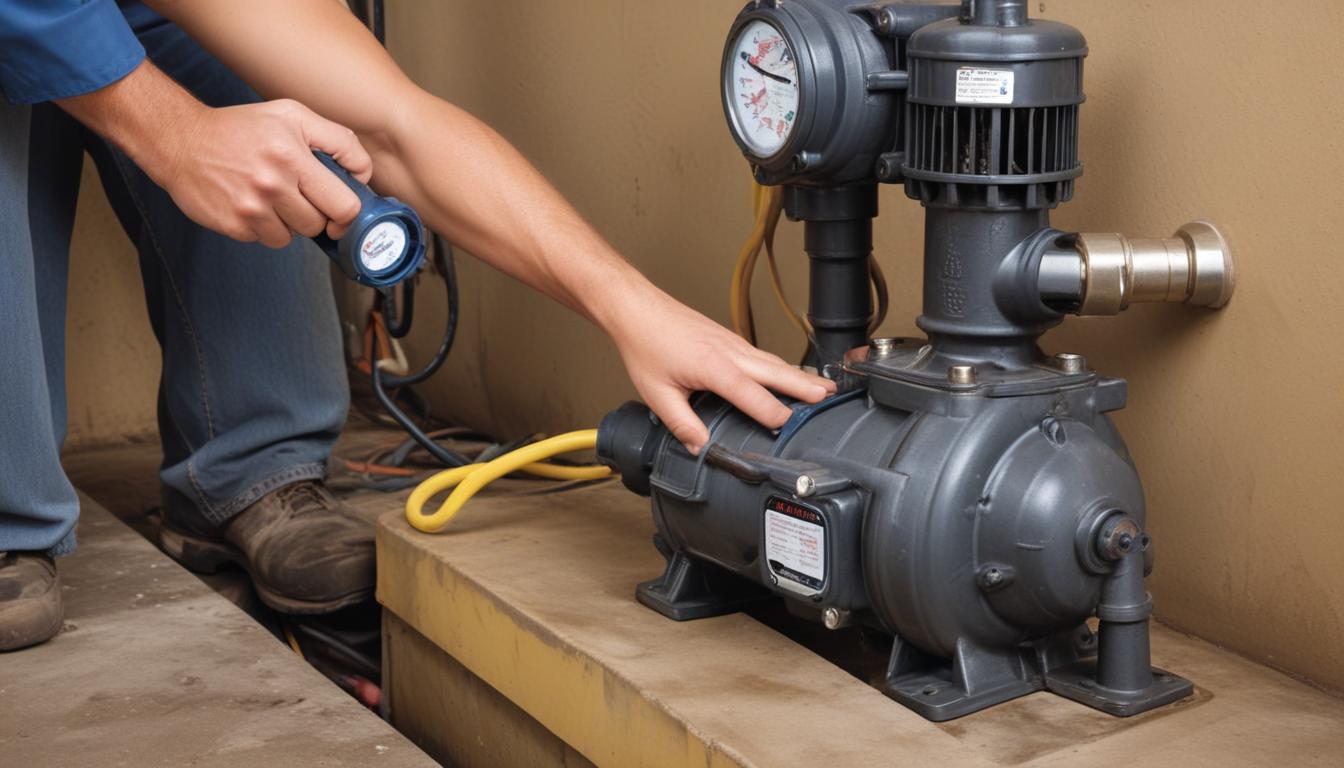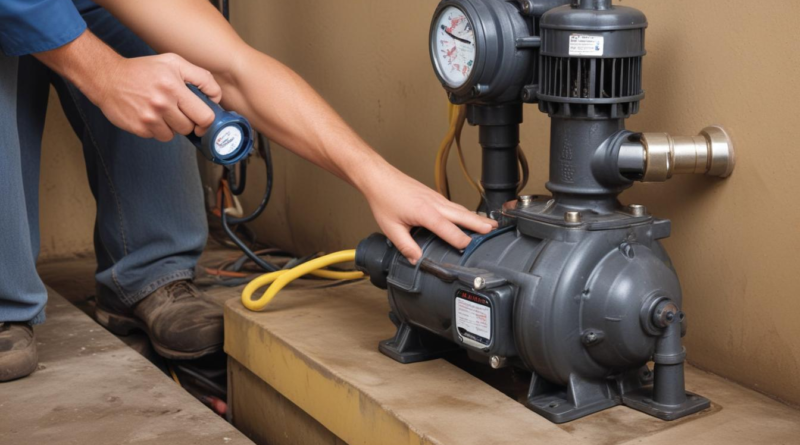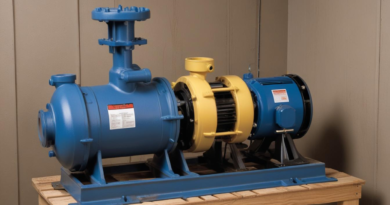how to troubleshoot pump electrical issues
Common pump electrical problems can significantly impact the performance and longevity of your pumping systems. Understanding these issues is crucial for effective troubleshooting and implementing appropriate solutions. Below is an overview of the most frequently encountered electrical problems in pumps:
| Problem | Symptoms | Possible Causes |
|---|---|---|
| Motor Not Starting |
|
|
| Overheating Motor |
|
|
| Tripping Breakers or Blown Fuses |
|
|
| Erratic Operation or Stalling |
|
|
| Unusual Noises or Vibrations |
|
|
| Intermittent Operation |
|
|
Identifying these common issues is the first step in diagnosing and rectifying pump electrical problems. Proper recognition of symptoms allows for targeted troubleshooting, ensuring that effective solutions can be applied to maintain optimal pump functionality and prevent downtime.
safety precautions before troubleshooting
Ensuring safety is paramount when addressing pump electrical problems. Adhering to proper safety protocols not only protects you but also prevents further damage to the equipment. Before commencing any troubleshooting, consider the following precautions:
- Disconnect the Power Supply: Always shut off and isolate the pump from its power source to eliminate the risk of electric shock. Verify that the power is completely off using a reliable voltage tester.
- Use Personal Protective Equipment (PPE): Equip yourself with appropriate PPE, such as insulated gloves, safety glasses, and protective footwear, to safeguard against accidental electrical contact and debris.
- Implement Lockout/Tagout (LOTO) Procedures: Apply lockout/tagout devices to ensure that the power remains disconnected while maintenance is performed. This prevents the inadvertent re-energization of the pump during repairs.
- Verify Absence of Voltage: After disconnecting the power, use a multimeter or voltage tester to confirm that no electrical current is present in the system before beginning work.
- Maintain a Clean Work Area: Keep the workspace free from moisture, clutter, and flammable materials to minimize the risk of electrical hazards and ensure efficient access to components.
- Use Insulated Tools: Utilize tools with insulated handles to provide an additional layer of protection against electrical shocks when working on live circuits.
- Be Aware of Environmental Conditions: Consider the surroundings, such as the presence of water, dust, or corrosive substances, which can affect electrical components and safety measures.
- Follow Manufacturer Guidelines: Adhere to the manufacturer’s safety instructions and recommended procedures for servicing and maintaining the pump to ensure compliance with safety standards.
By rigorously following these safety measures, you create a secure environment for diagnosing and resolving pump electrical issues. This not only protects personnel but also ensures that troubleshooting efforts are conducted efficiently and effectively, minimizing the risk of accidents and equipment damage.
checking power supply and connections
Ensuring a stable and reliable power supply is fundamental when diagnosing pump electrical problems. Inconsistencies or interruptions in power can lead to a range of issues, from minor performance fluctuations to complete system failures. The following steps outline a systematic approach to checking the power supply and connections effectively:
1. Verify Power Source Availability:
- Check the Main Power Switch: Ensure that the main power switch to the pump is in the “on” position. Sometimes, switches may inadvertently get turned off, leading to power loss.
- Assess Circuit Breakers and Fuses: Inspect the relevant circuit breakers and fuses for any signs of tripping or blowing. Reset tripped breakers or replace blown fuses as necessary.
- Measure Voltage Levels: Use a multimeter to confirm that the voltage supplied matches the pump’s specifications. Inadequate voltage can impair motor performance.
2. Inspect Power Cords and Plugs:
- Examine for Damage: Look for visible signs of wear, such as frayed wires, cracks in insulation, or bent prongs, which can disrupt the electrical flow.
- Ensure Secure Connections: Verify that all plugs are firmly connected to their respective outlets and that there is no looseness in the connections.
- Test Continuity: Utilize a continuity tester to ensure that there are no breaks in the power cords that could hinder electrical transmission.
3. Assess Electrical Terminals and Connectors:
- Tighten Loose Connections: Loose terminals can cause intermittent power supply issues. Use appropriate tools to secure all electrical connections firmly.
- Clean Corroded Contacts: Corrosion can impede electrical conductivity. Clean any corroded terminals with a suitable contact cleaner to restore optimal connections.
- Replace Damaged Connectors: If connectors exhibit significant wear or damage, replace them to ensure a reliable electrical pathway.
4. Inspect Control Panels and Switches:
- Check for Visible Damage: Look for burn marks, melted components, or other signs of electrical stress on control panels and switches.
- Test Functionality: Operate switches and control buttons to confirm they respond correctly. Faulty controls can disrupt power delivery to the pump.
- Replace Malfunctioning Components: If any control elements are not functioning as intended, replace them to restore proper power regulation.
5. Evaluate Grounding and Electrical Safety:
- Confirm Proper Grounding: Ensure that the pump is correctly grounded to prevent electrical hazards and ensure safe operation.
- Use Ground Fault Circuit Interrupters (GFCIs): Install GFCIs where necessary to enhance electrical safety and protect against faults.
- Inspect for Electrical Interference: Identify and mitigate sources of electrical interference that could disrupt the pump’s operation, such as nearby machinery or electronic devices.
6. Document Findings and Actions:
- Record Observations: Keep detailed notes of all inspections, measurements, and any irregularities discovered during the process.
- Implement Corrective Measures: Based on the identified issues, apply appropriate solutions to rectify power supply and connection problems.
- Schedule Regular Maintenance: Establish a routine maintenance schedule to periodically check the power supply and connections, preventing future pump electrical problems.
By meticulously following these steps, you can effectively diagnose and address power supply and connection issues, thereby enhancing the reliability and performance of your pumping systems. This thorough approach not only facilitates efficient troubleshooting but also contributes to the long-term sustainability of your equipment.
testing motor and electrical components
 Thorough examination of the motor and associated electrical components is essential in diagnosing and resolving pump electrical problems. This process involves systematically testing each component to identify any faults that may hinder the pump’s performance. The following steps provide a comprehensive approach to effectively test the motor and electrical parts:
Thorough examination of the motor and associated electrical components is essential in diagnosing and resolving pump electrical problems. This process involves systematically testing each component to identify any faults that may hinder the pump’s performance. The following steps provide a comprehensive approach to effectively test the motor and electrical parts:
1. Inspect the Motor:
- Visual Examination: Check the motor for any visible signs of damage, such as burn marks, melted parts, or physical distortions. Look for signs of overheating or wear that could indicate underlying issues.
- Listen for Unusual Sounds: Operate the pump and pay attention to any abnormal noises like grinding, squealing, or humming, which may signify mechanical or electrical faults.
2. Measure Motor Windings:
- Use a Multimeter: Set a multimeter to the resistance (ohms) setting and measure the resistance between the motor windings. Compare the readings against the manufacturer’s specifications to identify any discrepancies.
- Check for Insulation Breakdown: Perform an insulation resistance test to ensure that there is no short between the windings or between the windings and the motor frame. Low insulation resistance values indicate potential insulation failure.
3. Test Capacitors:
- Visual Inspection: Examine capacitors for bulging, leaking, or any physical damage. Damaged capacitors should be replaced immediately as they play a crucial role in motor startup and operation.
- Capacitance Measurement: Use a capacitance meter to verify that the capacitor’s value matches the rated specifications. Deviations can affect motor performance and lead to starting issues.
4. Evaluate Start and Run Relays:
- Functionality Test: Listen for clicking sounds from the relay during startup, indicating proper operation. Absence of clicking may point to a faulty relay.
- Continuity Check: With the power disconnected, use a multimeter to test for continuity in the relay contacts. Lack of continuity signifies a defective relay that needs replacement.
5. Assess the Motor Brushes and Commutator (if applicable):
- Brush Wear: Inspect motor brushes for excessive wear or damage. Worn brushes can cause poor electrical contact and motor malfunction.
- Commutator Condition: Check the commutator for smoothness and cleanliness. A rough or dirty commutator can lead to inefficient motor operation and increased electrical resistance.
6. Verify Electrical Connections:
- Tightness and Integrity: Ensure all electrical connections are secure and free from corrosion. Loose or corroded connections can disrupt electrical flow and cause intermittent pump operation.
- Wire Condition: Examine all wiring for signs of wear, such as fraying or cracking insulation, which can lead to short circuits or open circuits.
7. Utilize Diagnostic Tools:
| Tool | Purpose |
|---|---|
| Multimeter | Measure voltage, current, and resistance to identify electrical anomalies. |
| Clamp Meter | Assess current flow without disconnecting circuits, useful for detecting overcurrent conditions. |
| Oscilloscope | Analyze waveform anomalies that may indicate power supply issues or motor faults. |
| Insulation Resistance Tester | Evaluate the integrity of motor insulation to prevent electrical failures. |
8. Document Findings and Implement Solutions:
- Record Test Results: Maintain detailed records of all measurements and observations to track the condition of motor components over time.
- Identify Faults: Based on the test outcomes, pinpoint the specific components that require repair or replacement.
- Apply Corrective Actions: Implement the necessary solutions, such as replacing faulty capacitors, relays, or wiring, to restore optimal motor functionality.
- Re-test After Repairs: After addressing the identified issues, perform follow-up tests to ensure that the motor and electrical components are operating correctly.
By meticulously testing each motor and electrical component, you can effectively diagnose and address pump electrical problems. This comprehensive approach not only facilitates accurate troubleshooting but also ensures the implementation of reliable solutions to maintain the pump’s performance and extend its operational lifespan.
resolving wiring and control issues
Resolving wiring and control issues is critical in addressing pump electrical problems. Faulty wiring or malfunctioning control systems can lead to inconsistent pump performance, unexpected shutdowns, and even complete system failures. The following steps provide a structured approach to diagnosing and rectifying wiring and control-related issues:
1. Inspect Wiring for Physical Damage:
- Visual Inspection: Examine all wiring for signs of wear, such as frayed insulation, exposed conductors, or burnt sections. Damaged wires can cause short circuits or open circuits, disrupting the pump’s operation.
- Check for Pinched or Compressed Wires: Ensure that wires are not pinched by adjacent components or confined within tight spaces, which can degrade the insulation and lead to electrical faults.
2. Verify Wire Connections and Terminations:
- Secure Connections: Ensure that all wire connections are tight and secure. Loose connections can result in intermittent power supply and unreliable pump behavior.
- Proper Termination: Confirm that wires are correctly terminated according to the manufacturer’s wiring diagram. Incorrect connections can lead to improper functioning of the control system.
3. Test for Continuity and Resistance:
- Use a Multimeter: Set the multimeter to the continuity or resistance (ohms) setting to test each wire for proper electrical pathways. A lack of continuity indicates a break in the wire, while unusually high resistance may suggest partial damage or corrosion.
- Identify Open Circuits: Systematically test each segment of the wiring to identify open circuits that could prevent the pump from receiving the necessary power.
4. Examine Control Components:
- Control Switches and Relays: Inspect all control switches, relays, and contactors for signs of wear or failure. Replace any components that do not operate smoothly or show visible damage.
- Programmable Logic Controllers (PLCs): If your pump system uses a PLC, ensure that the programming is correct and that there are no errors or faults within the controller.
5. Assess the Control Circuit:
- Signal Integrity: Verify that control signals are being properly transmitted and received. Faulty control circuits can lead to improper pump start-up sequences or failure to respond to commands.
- Interference and Noise: Identify and mitigate sources of electrical interference that could disrupt the control signals. Use shielded cables and proper grounding techniques to enhance signal integrity.
6. Inspect Grounding and Bonding:
- Proper Grounding: Ensure that all electrical components, including the pump motor and control system, are properly grounded. Effective grounding prevents electrical shocks and reduces the risk of equipment damage.
- Bonding of Components: Verify that all metallic parts of the pump system are properly bonded to maintain a consistent electrical potential and prevent stray currents.
7. Utilize Diagnostic Tools:
| Tool | Purpose |
|---|---|
| Multimeter | Measure voltage, current, and resistance to identify electrical anomalies in wiring and control circuits. |
| Insulation Tester | Assess the integrity of wire insulation to prevent short circuits and electrical leakage. |
| Oscilloscope | Analyze control signal waveforms for irregularities that may indicate faults in the control system. |
| Network Analyzer | Evaluate the performance of communication networks within programmable control systems. |
8. Implement Corrective Actions:
- Repair or Replace Damaged Wires: Replace any wires that show signs of physical damage or electrical degradation to restore proper electrical pathways.
- Reconnect Loose Terminals: Secure any loose connections and ensure that all terminals are properly fastened to maintain reliable electrical contacts.
- Update Control Software: If issues are traced to the control software, update or reprogram the PLC to resolve logic errors and enhance system performance.
9. Perform Functional Testing:
- Test Pump Operation: After making repairs, run the pump to ensure that all wiring and control issues have been resolved and that the pump operates smoothly.
- Monitor for Recurrence: Observe the pump’s performance over a period of time to confirm that the troubleshooting steps have effectively addressed the issues and that no new problems arise.
10. Document the Process:
- Record Findings: Keep detailed records of all inspections, tests, and repairs performed. This documentation aids in future troubleshooting and maintenance efforts.
- Update Wiring Diagrams: Ensure that any changes made to the wiring or control systems are reflected in the official documentation to maintain accurate records for ongoing maintenance.
By systematically addressing wiring and control issues through these steps, you can effectively resolve pump electrical problems. Implementing these solutions not only restores the pump’s functionality but also enhances the overall reliability and efficiency of your pumping system. Regular maintenance and thorough documentation further contribute to minimizing future electrical complications, ensuring sustained optimal performance.




